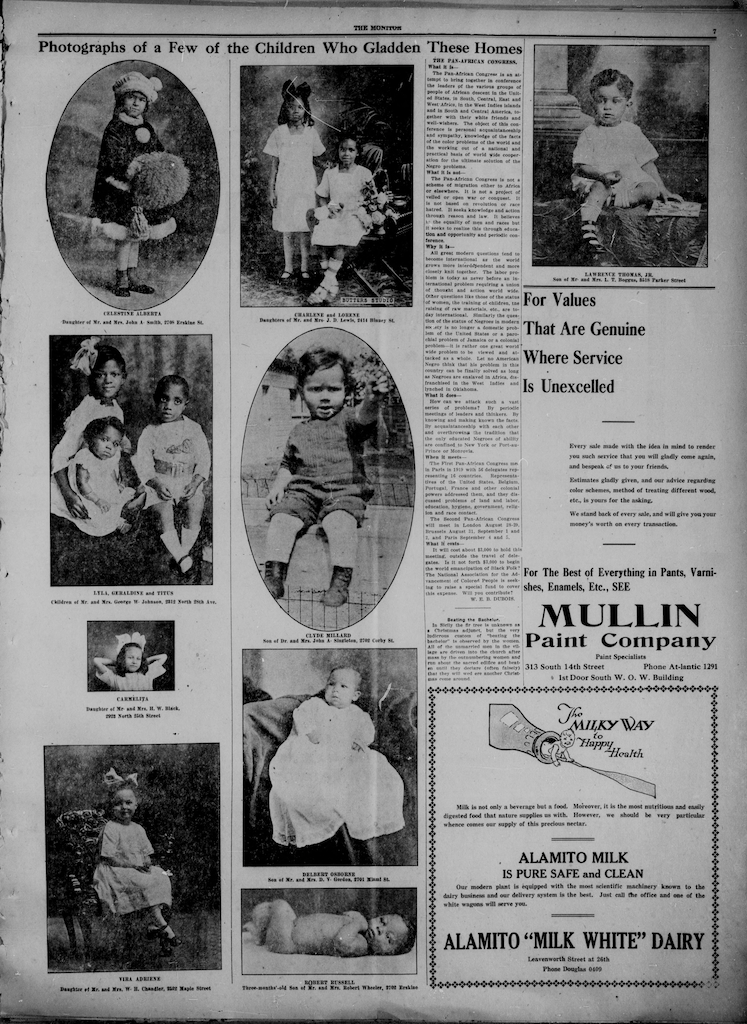Newspaper Article Promoting the Pan-African Congress

Annotation
This article appears in the August 4, 1921 edition of the Omaha, Nebraska based newspaper, The Monitor. The Monitor was an African American run newspaper and typically featured stories about African Americans. This article contains quotes from African American intellectual, writer, and activist W.E.B. Du Bois, an organizer and American delegate for the 1919 Pan-African Congress. The article follows a question-and-answer pattern and offers readers insight into the who, what, when, where and why of the Pan-African Congress. The author notes that “Pan-African” refers to all the people of African descent regardless of national identity and reveals that the Pan-African Congress seeks to unite Pan-Africans and their white allies in a fellowship that seeks to address the “color problem” (a term used during this period to describe racial inequality and white racial and political hegemony) at the international level through cooperation, rather than local level. The article also makes reference to all modern problems having an international dimension and directly ties the fate of people of color living in the United States to those living in Jamacia or other parts of the world noting that the modern world is an interdependent world. The article also emphasizes that “the Pan-African Congress is not a scheme of migration to Africa or elsewhere.” Although the article does not specifically explain this, this is likely a reference to Garveyism and Ethiopianism, other competing black nationalist movements during this period that sometimes advocated for people of African descent to migrate to Africa. The author also explains that the Congress “is not a project of veiled or open war or conquest. It is not based on revolution or race hatred. It seeks knowledge and action through reason and law.” This clarification is likely a preemptive response to anyone wishing to discredit the group or its intentions. The article ends with a note about how the NAACP is helping to fund the Pan-African Congress’ upcoming meeting and asks if readers will contribute financially to the cause.
This source is part of the source collection on the Pan-African movement's activism against the global color line.
Transcription
“The Pan African Congress”
What It is—
The Pan-African Congress is an attempt to bring together in conference the leaders pf the various groups of
people of African descent in the United States, in South, Central, East and West-Africa, in the West Indies islands and in South and Central America, together with their white friends and well-wishers. The object of this conference is personal acquaintanceship and sympathy, knowledge of the facts of the color problems of the world and the working out of a national and practical basis of world wide cooperation for the ultimate solution of the Negro problems.
What it is not—
The Pan-African Congress is not a scheme of migration either to Africa or elsewhere. It is not a project of
veiled or open war or conquest. It is not based on revolution or race hatred. It seeks knowledge and action
through reason and law. It believes in the equality of men and races but it seeks to realize this through education and opportunity and periodic conference.
Why it Is—
All great modern questions tend to become international as the world grows more interdependent and more
closely knit together. The labor problem is today as never before an international problem requiring a union
of thought and action world wide. Other questions like those of the status of women, the training of children, the raising of raw materials, etc., are today international. Similarly the question of the status of Negroes in modern society is no longer a domestic problem of the United States or a parochial problem of Jamaica or a colonial problem it is rather one great world'' wide problem to be viewed and attacked as a whole. Let no American Negro think that his problem in this country can be finally solved as long as Negroes are enslaved in Africa, disfranchised in the West Indies and lynched in Oklahoma.
What it does—
How can we attack such a vast series of problems? By periodic meetings of leaders and thinkers. By knowing and making known the facts. By acquaintanceship with each other and overthrowing the tradition that
the only educated Negroes of ability are confined to New York or Port-auPrince or Monrovia.
When it meets—
The First Pan-African Congress met in Paris in 1919 with 56 delegates representing 16 countries. Representatives of the United States, Belgium, Portugal, France and other colonial powers addressed them, and they discussed problems of land and labor, education, hygiene, government, religion and race contact.
The Second Pan-African Congress will meet in London August 28-29, Brussels August 31, September 1 and
2, and Paris September 4 and 5.
What it costs—
It will cost about $3,000 to hold this meeting, outside the travel of delegates. Is it not forth $3,000 to begin
the world emancipation of Black Folk? The National Association for the Advancement of Colored People is seeking to raise a special fund to cover this expense. Will you contribute?
W. E. B. DUBOIS.
Credits
Library of Congress
Chronicling America: Historic American Newspapers
Link: https://chroniclingamerica.loc.gov/lccn/00225879/1921-08-04/ed-1/seq-7/